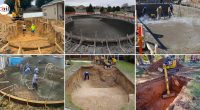Basic important points for civil site engineers and supervisors
1. Height of building = 3.15m.
2. The height of the Parapet wall should be 1m.
3. Height of window = 2.1m.
4. Minimum thickness of slab = 125mm.
5. Minimum thickness of lintel = 15cm.
6. Thickness of DPC = 2.5cm.
7. Maximum diameter of the bars used for lapping is 36mm.
Bars having more than this diameter are not allowed.
8. Minimum diameter of bars used in Slab = 8mm.
9. Minimum diameter of bars used in Column = 12mm.
10. Minimum number of bars used in Square or Rectangular Column = 4 bars.
11. Minimum number of bars used in Circular Column = 6 bars.
12. Maximum diameter of bars used in Slab = 1/8 x thickness of slab.
13. Maximum Chair spacing = 1m.
14. Chairs minimum of 12 mm diameter bars to be used.
15. The minimum diameter used for Dowels Bars is 12mm.
16. Longitudinal reinforcement should not be less than 0.8% and not be more than 6% of the gross area of the cross-section.
17. Binding wire required in steel reinforcement is 8kg per
MT.
18. Weight of 1 cement bag = 50kg.
19. 1 bag of cement = 1.25 cubit feet = 0.0347 cubic meter.
20. No. of Cement Bags in 1m3 = 28.8 bags.
21. Initial setting time of Cement = 30 minutes.
22. Final setting time of Cement = 10hrs = 600 minutes.
23. The PH value of the water should not be less than 6.
24. Riser of staircase = 150mm to 200mm.
25. Tread of staircase = 250mm to 300mm.
26. Angle of staircase = 25° to 40°.
27. Tensile or Flexural strength of concrete = 0.7√fck.
28. Modulus of elasticity of concrete = [Ec=5000√fck].
29. Young’s modulus of steel = [Es=2×10^5 N/mm2].
30. F.O.S for steel = 1.15.
31. F.O.S for Concrete = 1.5.
32. Standard size of Brick = 190mmx90mm×90 mm = 19cmx9cmx9cm.
33. A good brick clay contains 20 to 30% of alumina and 50 to 60% of silica and the remaining constituents are Lime, Magnesia, Sodium, Potassium, Manganese, and iron oxide.
34. The color of good brick is deep red, cherry, or copper colored.
35. The compressive strength of bricks is 3.5 N/mm2.
36. Maximum water absorption of first-class brick is 15% of its dry weight.
37. The excess of silica in the clay makes the brick brittle and weak.
38. The process of manufacturing bricks consists of the Preparation of brick clay, Moulding bricks, Drying of bricks, and Burning of bricks.
39. Moulding of bricks may be hand molding or machine molding.
40. The burning of dry bricks is done either in a clamp or in a kiln.
41. The ingredients of ordinary cement are Lime, Silica, Alumina, Calcium sulfate, Iron oxide, magnesium, Sulphur, and alkalis.
42. Ordinary Portland cement consists of 62 to 67% of Lime.
43. The initial setting time of ordinary Portland cement should not be less than 30 minutes.
44. The final setting time of ordinary Portland cement should not be more than 10 hours.
45. The initial and Final setting time of cement is determined by Vicat’s apparatus.
46. The normal consistency of Portland cement is about 25%.
48. Maximum free fall of concrete allowed to 1.50m.
49. Test On Fresh Concrete
- Slump Test – Workability.
- Compacting Factor Test.
- Vee-Bee Test.
50. Test On Hardened Concrete
- Rebound (Schmidt) Hammer Test.
- Ultrasonic Pulse Velocity Test.
51. Concrete Grades
- M5 = 1:5:10
- M7.5 = 1:4:8
- M10 =1:3:6
- M15 = 1:2:4
- M20 = 1:1.5:3
- M25 = 1:1:2
- M30 & above grade based on Design Mix.
Click Here To See Why Civil Engineers Used White Cap At Site?






